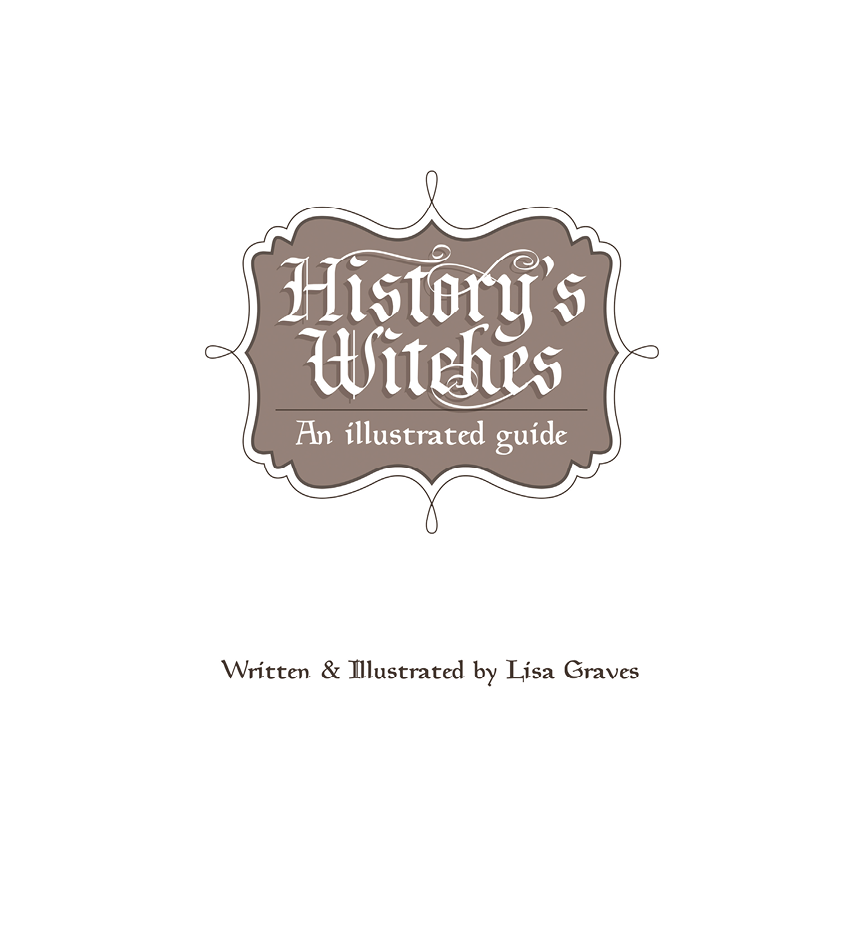
Copyright Lisa Graves 2013 All Rights Reserved. No portion of this book may be reproduced without express permission from the publisher. ISBN: 9781623955168 eISBN: 9781623955175 ePib ISBN: 9781623955182
Published in the United States by Xist Publishing www.xistpublishing.com
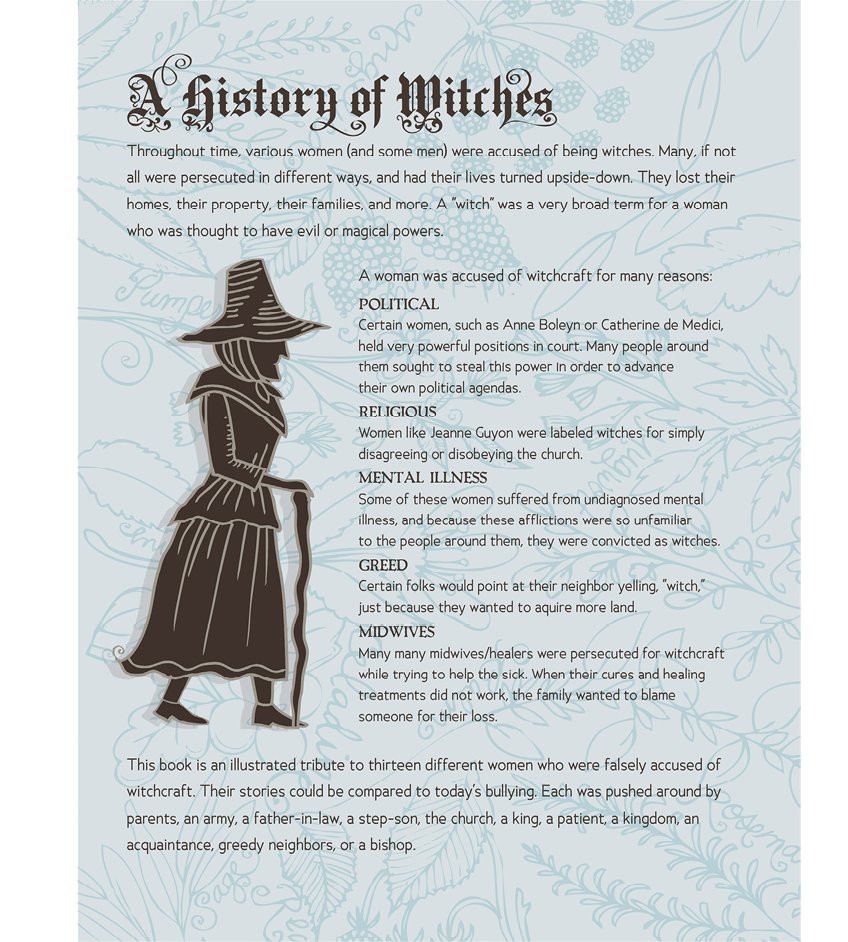
Throughout time, various women (and some men) were accused of being witches. Many, if not all were persecuted in different ways, and had their lives turned upside-down. They lost their homes, their property, their families, and more. A witch was a very broad term for a woman who was thought to have evil or magical powers.
A woman was accused of witchcraft for many reasons: POLITICAL Certain women, such as Anne Boleyn or Catherine de Medici, held very powerful positions in court.
Many people around them sought to steal this power in order to advance their own political agendas. RELIGIOUS Women like Jeanne Guyon were labeled witches for simply disagreeing or disobeying the church. MENTAL ILLNESS Some of these women suffered from undiagnosed mental illness, and because these afflictions were so unfamiliarto the people around them, they were convicted as witches. GREED Certain folks would point at their neighbor yelling, witch, just because they wanted to aquire more land. MIDWIVES Many many midwives/healers were persecuted for witchcraft while trying to help the sick. When their cures and healing treatments did not work, the family wanted to blame someone for their loss.
This book is an illustrated tribute to thirteen different women who were falsely accused of witchcraft. Their stories could be compared to todays bullying. Each was pushed around by parents, an army, a father-in-law, a step-son, the church, a king, a patient, a kingdom, an acquaintance, greedy neighbors, or a bishop. 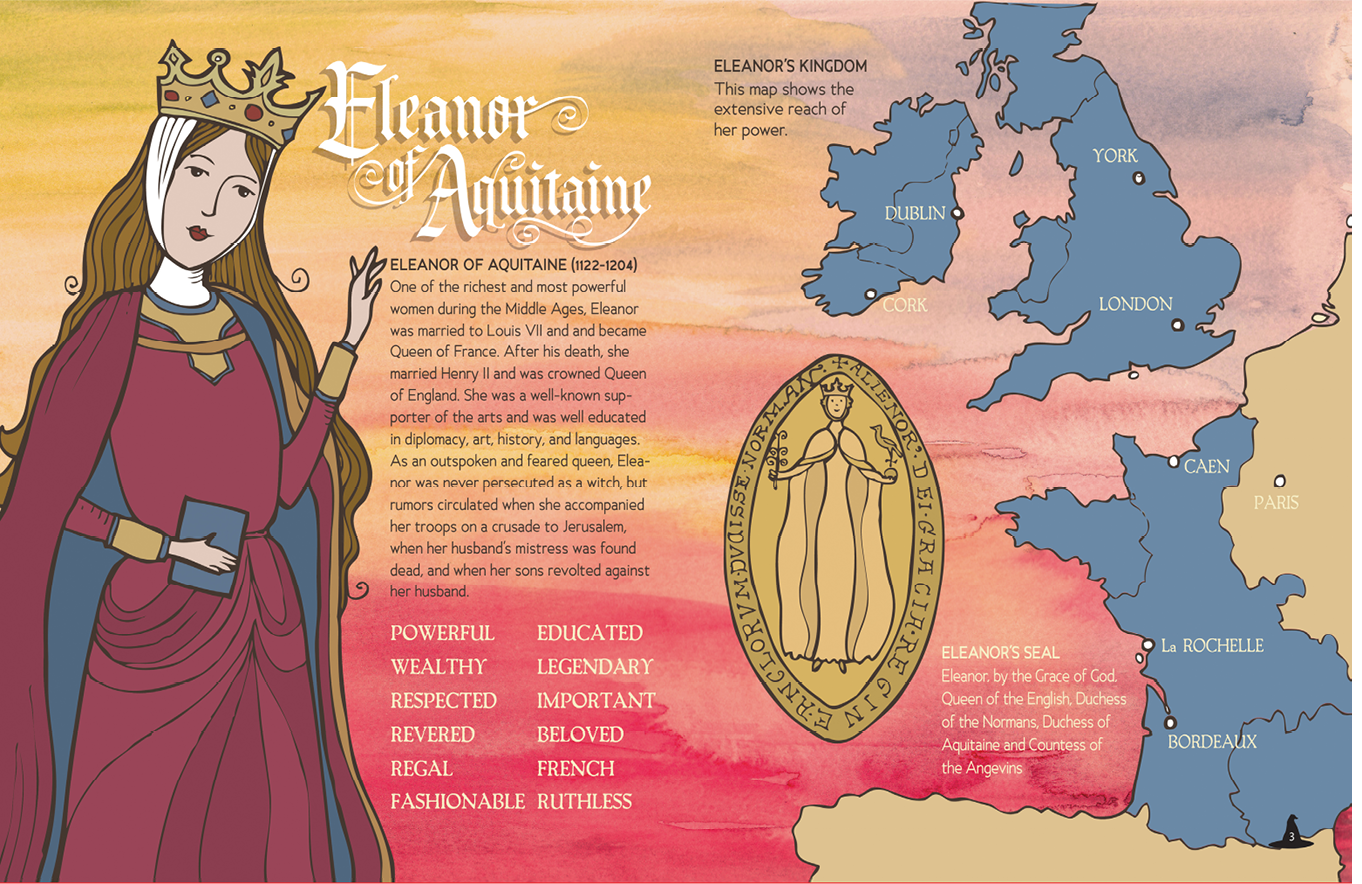 ELEANOR OF AQUITAINE (1122-1204) One of the richest and most powerful women during the Middle Ages, Eleanor was married to Louis VII and became Queen of France. After his death, she married Henry II and was crowned Queen of England. She was a well-known supporter of the arts and was well educated in diplomacy, art, history, and languages.
ELEANOR OF AQUITAINE (1122-1204) One of the richest and most powerful women during the Middle Ages, Eleanor was married to Louis VII and became Queen of France. After his death, she married Henry II and was crowned Queen of England. She was a well-known supporter of the arts and was well educated in diplomacy, art, history, and languages.
As an outspoken and feared queen, Eleanor was never persecuted as a witch, but rumors circulated when she accompanied her troops on a crusade to Jerusalem, when her husbands mistress was found dead, and when her sons revolted against her husband.
ELEANORS KINGDOM
This map shows the extensive reach of her power.
ELEANORS SEAL
Eleanor, by the Grace of God, Queen of the English, Duchess of the Normans, Duchess of Aquitaine and Countess of the Angevins
ELEANOR WAS: POWERFUL WEALTHY RESPECTED REVERED REGAL FASHIONABLE
EDUCATED LEGENDARY IMPORTANT BELOVED FRENCH RUTHLESS 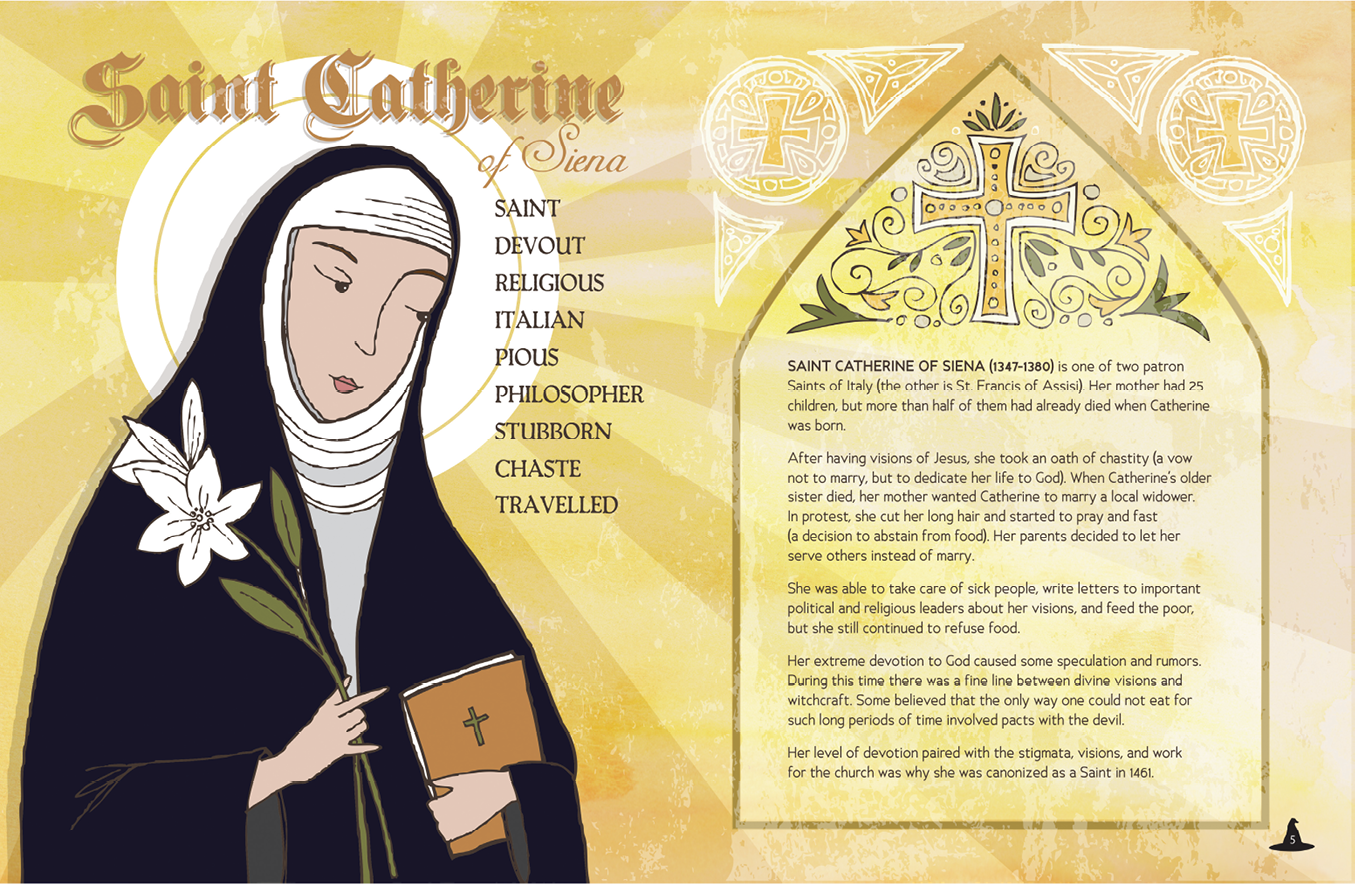 SAINT CATHERINE OF SIENA (1347-1380) is one of two patron Saints of Italy (the other is St. Francis of Assisi). Her mother had 25 children, but more than half of them had already died when Catherine was born. After having visions of Jesus, she took an oath of chastity (a vow not to marry, but to dedicate her life to God).
SAINT CATHERINE OF SIENA (1347-1380) is one of two patron Saints of Italy (the other is St. Francis of Assisi). Her mother had 25 children, but more than half of them had already died when Catherine was born. After having visions of Jesus, she took an oath of chastity (a vow not to marry, but to dedicate her life to God).
When Catherines older sister died, her mother wanted Catherine to marry a local widower. In protest, she cut her long hair and started to pray and fast(a decision to abstain from food). Her parents decided to let her serve others instead of marry. She was able to take care of sick people, write letters to important political and religious leaders about her visions, and feed the poor, but she still continued to refuse food. Her extreme devotion to God caused some speculation and rumors. During this time there was a fine line between divine visions and witchcraft.
Some believed that the only way one could not eat for such long periods of time involved pacts with the devil. Her level of devotion paired with the stigmata, visions, and work for the church was why she was canonized as a Saint in 1461.
CATHERINE WAS: SAINT DEVOUT RELIGIOUS ITALIAN PIOUS PHILOSOPHER STUBBORN CHASTE TRAVELED 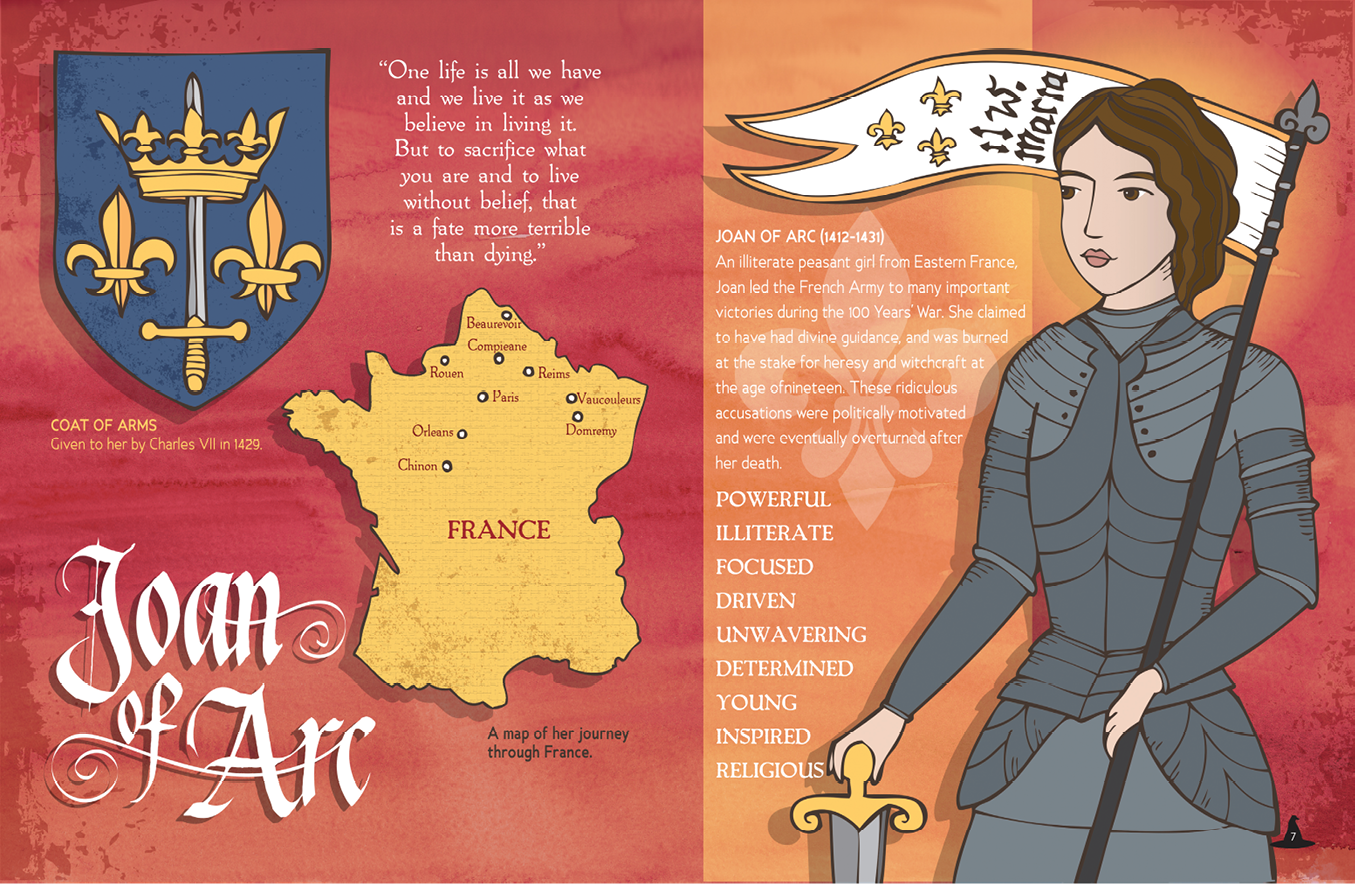 JOAN OF ARC (1412-1431) An illiterate peasant girl from Eastern France, Joan led the French Army to many important victories during the 100 Years War. She claimed to have had divine guidance, and was burned at the stake for heresy and witchcraft at the age of nineteen. These ridiculous accusations were politically motivated and were eventually overturned after her death.
JOAN OF ARC (1412-1431) An illiterate peasant girl from Eastern France, Joan led the French Army to many important victories during the 100 Years War. She claimed to have had divine guidance, and was burned at the stake for heresy and witchcraft at the age of nineteen. These ridiculous accusations were politically motivated and were eventually overturned after her death.
One life is all we have and we live it as we believe in living it. But to sacrifice what you are and to live without belief, that is a fate more terrible than dying.
A map of her journey through France.
COAT OF ARMS Given to her by Charles VII in 1429.
JOAN WAS:
POWERFUL ILLITERATE FOCUSED DRIVEN UNWAVERING DETERMINED YOUNG INSPIRED RELIGIOUS 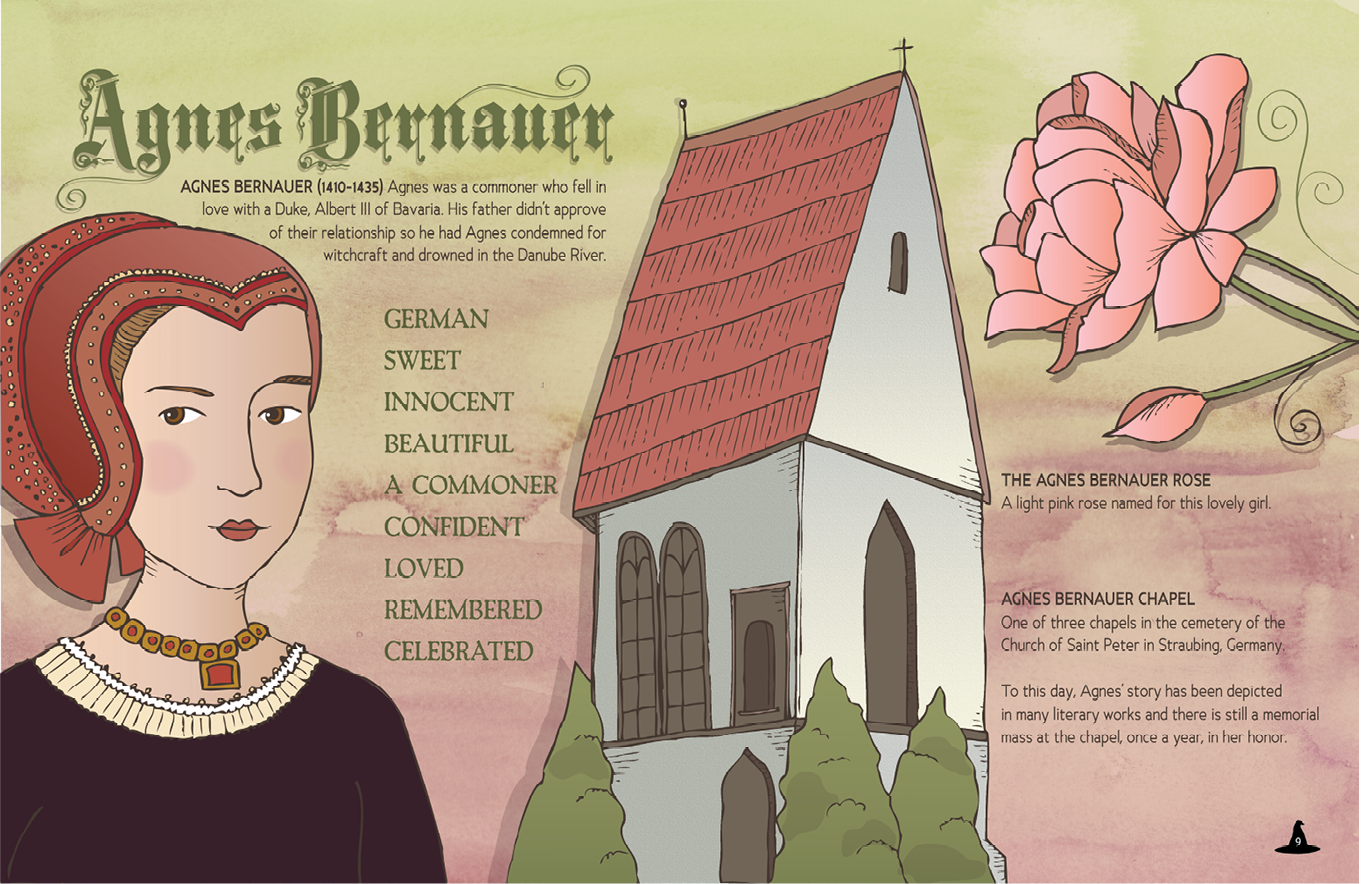 AGNES BERNAUER (1410-1435) Agnes was a commoner who fell in love with a Duke, Albert III of Bavaria. His father didnt approve of their relationship so he had Agnes condemned for witchcraft and drowned in the Danube River.
AGNES BERNAUER (1410-1435) Agnes was a commoner who fell in love with a Duke, Albert III of Bavaria. His father didnt approve of their relationship so he had Agnes condemned for witchcraft and drowned in the Danube River.
AGNES BERNAUER CHAPEL One of three chapels in the cemetery of the Church of Saint Peter in Straubing, Germany. To this day, Agnes story has been depicted in many literary works and there is still a memorial mass at the chapel, once a year, in her honor.
THE AGNES BERNAUER ROSE A light pink rose named for this lovely girl.
AGNES WAS:
GERMAN SWEET INNOCENT BEAUTIFUL A COMMONER CONFIDENT LOVED REMEMBERED CELEBRATED 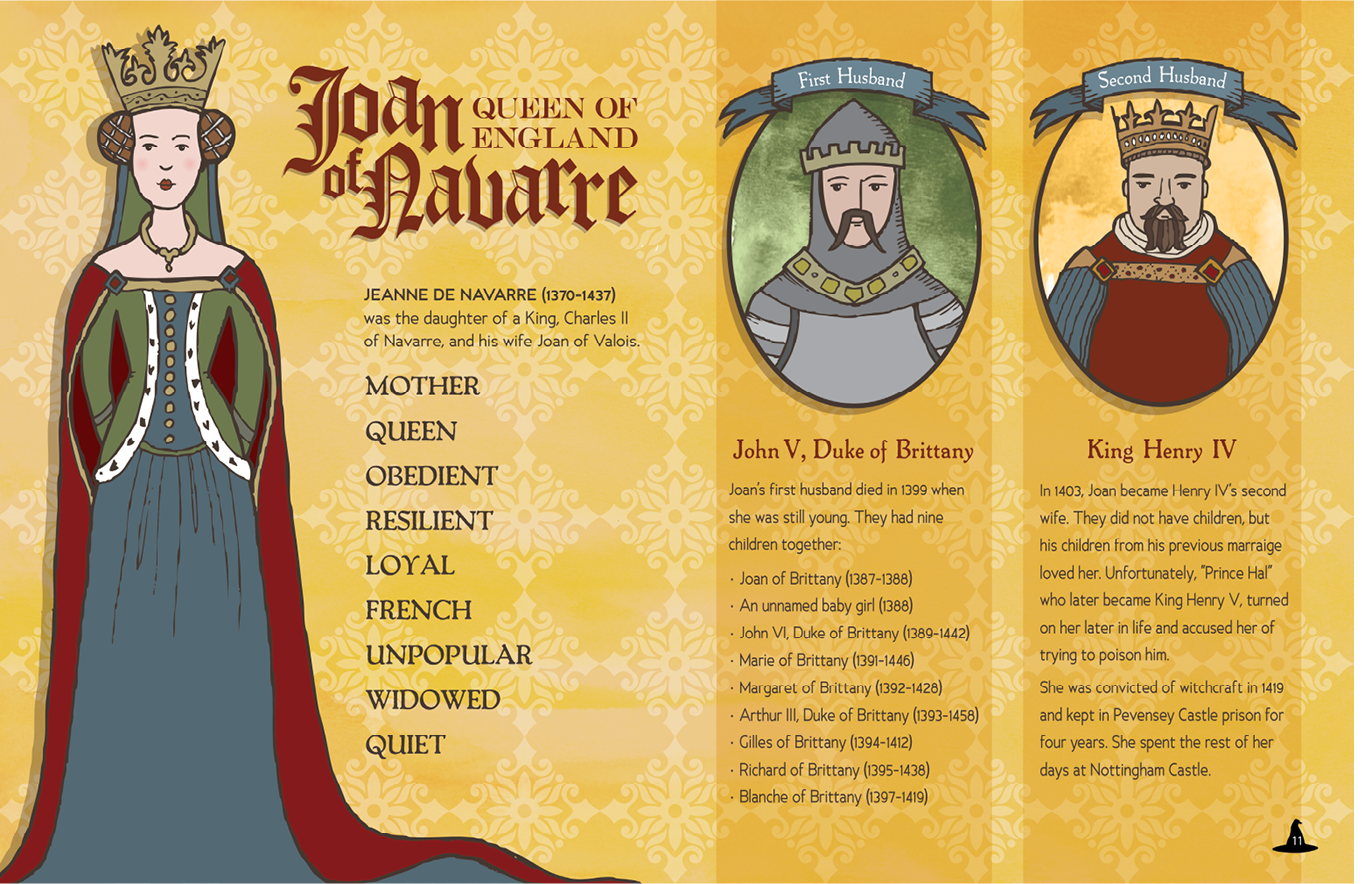 JEANNE DE NAVARRE (1370-1437) was the daughter of a King, Charles II of Navarre, and his wife Joan of Valois.
JEANNE DE NAVARRE (1370-1437) was the daughter of a King, Charles II of Navarre, and his wife Joan of Valois.
John V, Duke of Brittany Joans first husband died in 1399 when she was still young. They had nine children together.: Joan of Brittany (1387-1388) An unnamed baby girl (1388) John VI, Duke of Brittany (1389-1442) Marie of Brittany (1391-1446) Margaret of Brittany (1392-1428) Arthur III, Duke of Brittany (1393-1458) Gilles of Brittany (1394-1412) Richard of Brittany (1395-1438) Blanche of Brittany (1397-1419)
King Henry IV In 1403, Joan became Henry IVs second wife. They did not have children, but his children from his previous marriage loved her. Unfortunately, Prince Hal who later became King Henry V, turned on her later in life and accused her of trying to poison him.
She was convicted of witchcraft in 1419 and kept in Pevensey Castle prison for four years. She spent the rest of her days at Nottingham Castle.
JEANNE WAS:
MOTHER QUEEN OBEDIENT RESILIENT LOYAL FRENCH UNPOPULAR WIDOWED QUIET
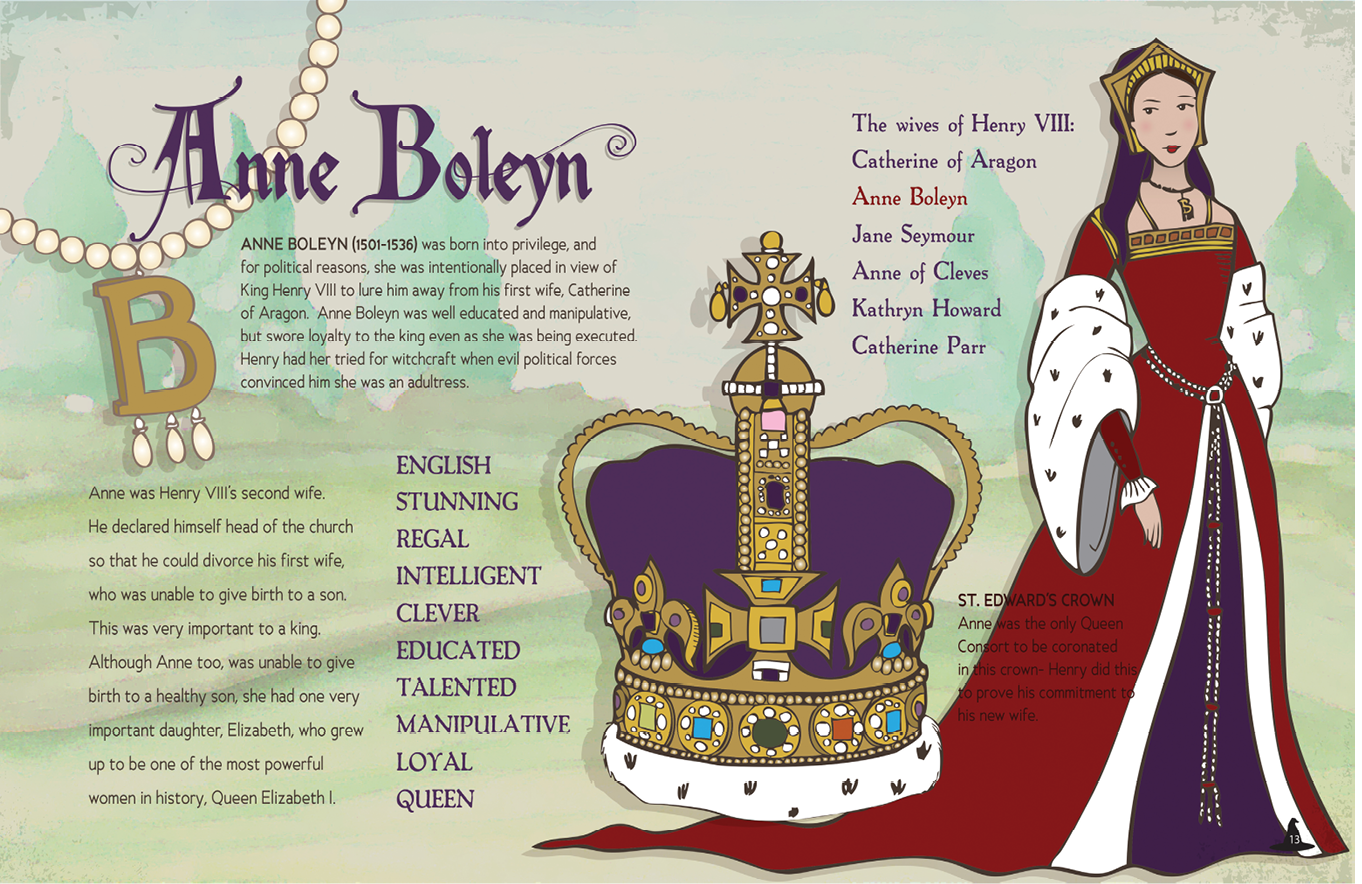 ANNE BOLEYN (1501-1536) was born into privilege, and for political reasons, she was intentionally placed in view of King Henry VIII to lure him away from his first wife, Catherine of Aragon. Anne Boleyn was well educated and manipulative, but swore loyalty to the King even as she was being executed. Henry had her tried for witchcraft when evil political forces convinced him she was an adulteress.
ANNE BOLEYN (1501-1536) was born into privilege, and for political reasons, she was intentionally placed in view of King Henry VIII to lure him away from his first wife, Catherine of Aragon. Anne Boleyn was well educated and manipulative, but swore loyalty to the King even as she was being executed. Henry had her tried for witchcraft when evil political forces convinced him she was an adulteress.











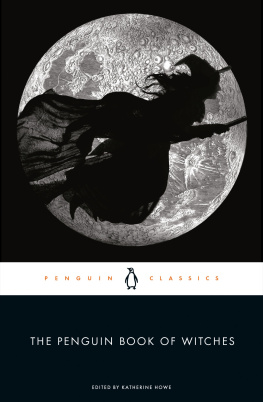


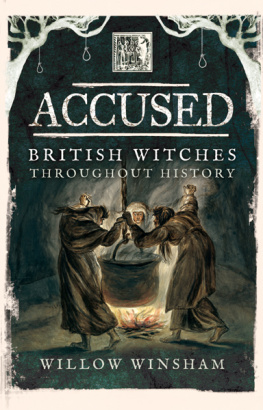
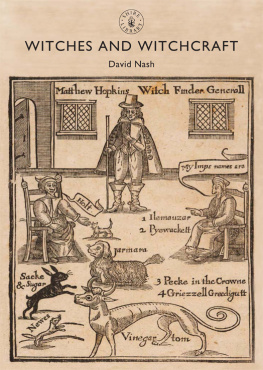
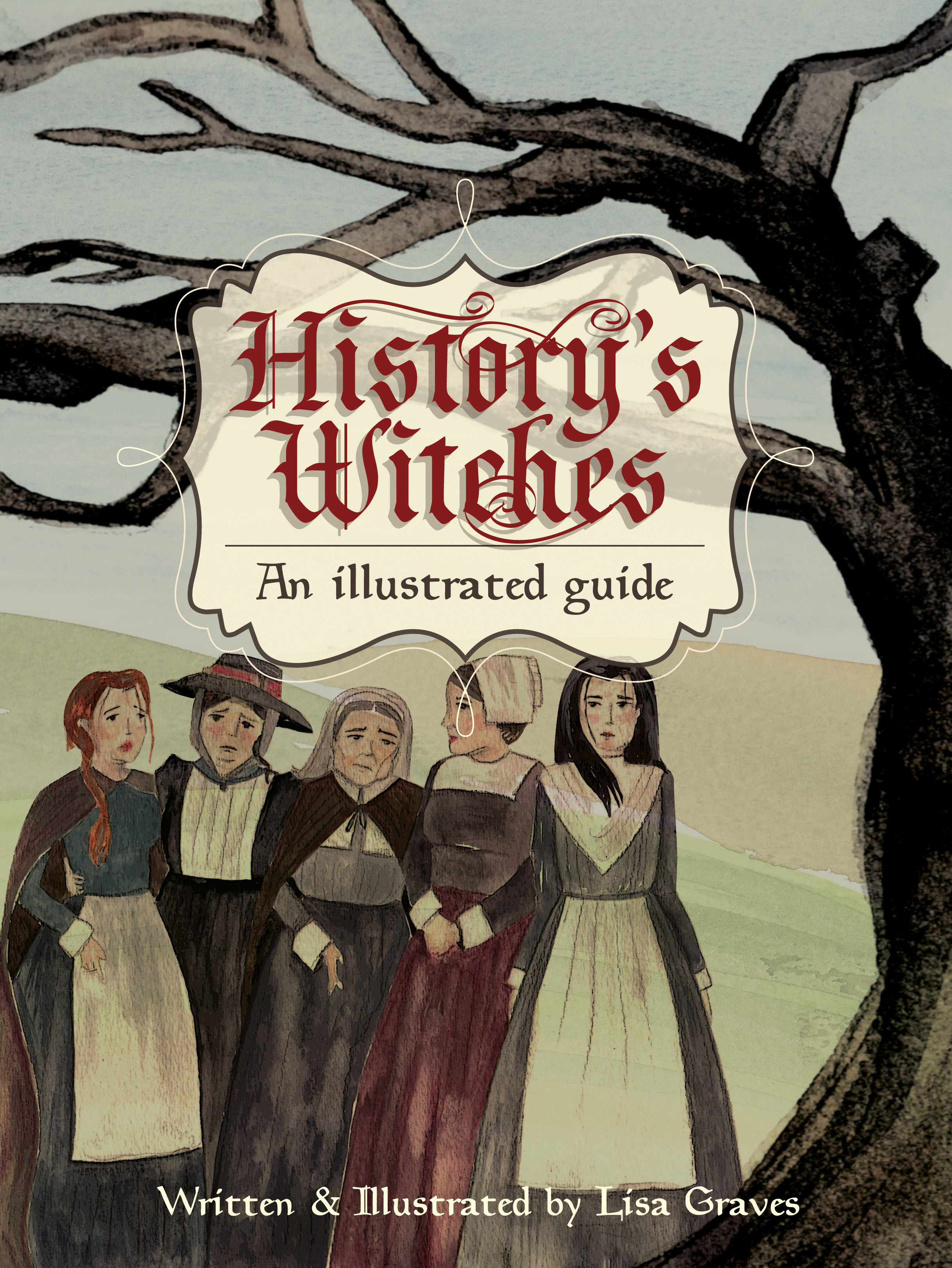
 Copyright Lisa Graves 2013 All Rights Reserved. No portion of this book may be reproduced without express permission from the publisher. ISBN: 9781623955168 eISBN: 9781623955175 ePib ISBN: 9781623955182
Copyright Lisa Graves 2013 All Rights Reserved. No portion of this book may be reproduced without express permission from the publisher. ISBN: 9781623955168 eISBN: 9781623955175 ePib ISBN: 9781623955182 Throughout time, various women (and some men) were accused of being witches. Many, if not all were persecuted in different ways, and had their lives turned upside-down. They lost their homes, their property, their families, and more. A witch was a very broad term for a woman who was thought to have evil or magical powers.
Throughout time, various women (and some men) were accused of being witches. Many, if not all were persecuted in different ways, and had their lives turned upside-down. They lost their homes, their property, their families, and more. A witch was a very broad term for a woman who was thought to have evil or magical powers. ELEANOR OF AQUITAINE (1122-1204) One of the richest and most powerful women during the Middle Ages, Eleanor was married to Louis VII and became Queen of France. After his death, she married Henry II and was crowned Queen of England. She was a well-known supporter of the arts and was well educated in diplomacy, art, history, and languages.
ELEANOR OF AQUITAINE (1122-1204) One of the richest and most powerful women during the Middle Ages, Eleanor was married to Louis VII and became Queen of France. After his death, she married Henry II and was crowned Queen of England. She was a well-known supporter of the arts and was well educated in diplomacy, art, history, and languages. SAINT CATHERINE OF SIENA (1347-1380) is one of two patron Saints of Italy (the other is St. Francis of Assisi). Her mother had 25 children, but more than half of them had already died when Catherine was born. After having visions of Jesus, she took an oath of chastity (a vow not to marry, but to dedicate her life to God).
SAINT CATHERINE OF SIENA (1347-1380) is one of two patron Saints of Italy (the other is St. Francis of Assisi). Her mother had 25 children, but more than half of them had already died when Catherine was born. After having visions of Jesus, she took an oath of chastity (a vow not to marry, but to dedicate her life to God). JOAN OF ARC (1412-1431) An illiterate peasant girl from Eastern France, Joan led the French Army to many important victories during the 100 Years War. She claimed to have had divine guidance, and was burned at the stake for heresy and witchcraft at the age of nineteen. These ridiculous accusations were politically motivated and were eventually overturned after her death.
JOAN OF ARC (1412-1431) An illiterate peasant girl from Eastern France, Joan led the French Army to many important victories during the 100 Years War. She claimed to have had divine guidance, and was burned at the stake for heresy and witchcraft at the age of nineteen. These ridiculous accusations were politically motivated and were eventually overturned after her death. AGNES BERNAUER (1410-1435) Agnes was a commoner who fell in love with a Duke, Albert III of Bavaria. His father didnt approve of their relationship so he had Agnes condemned for witchcraft and drowned in the Danube River.
AGNES BERNAUER (1410-1435) Agnes was a commoner who fell in love with a Duke, Albert III of Bavaria. His father didnt approve of their relationship so he had Agnes condemned for witchcraft and drowned in the Danube River. JEANNE DE NAVARRE (1370-1437) was the daughter of a King, Charles II of Navarre, and his wife Joan of Valois.
JEANNE DE NAVARRE (1370-1437) was the daughter of a King, Charles II of Navarre, and his wife Joan of Valois. ANNE BOLEYN (1501-1536) was born into privilege, and for political reasons, she was intentionally placed in view of King Henry VIII to lure him away from his first wife, Catherine of Aragon. Anne Boleyn was well educated and manipulative, but swore loyalty to the King even as she was being executed. Henry had her tried for witchcraft when evil political forces convinced him she was an adulteress.
ANNE BOLEYN (1501-1536) was born into privilege, and for political reasons, she was intentionally placed in view of King Henry VIII to lure him away from his first wife, Catherine of Aragon. Anne Boleyn was well educated and manipulative, but swore loyalty to the King even as she was being executed. Henry had her tried for witchcraft when evil political forces convinced him she was an adulteress.